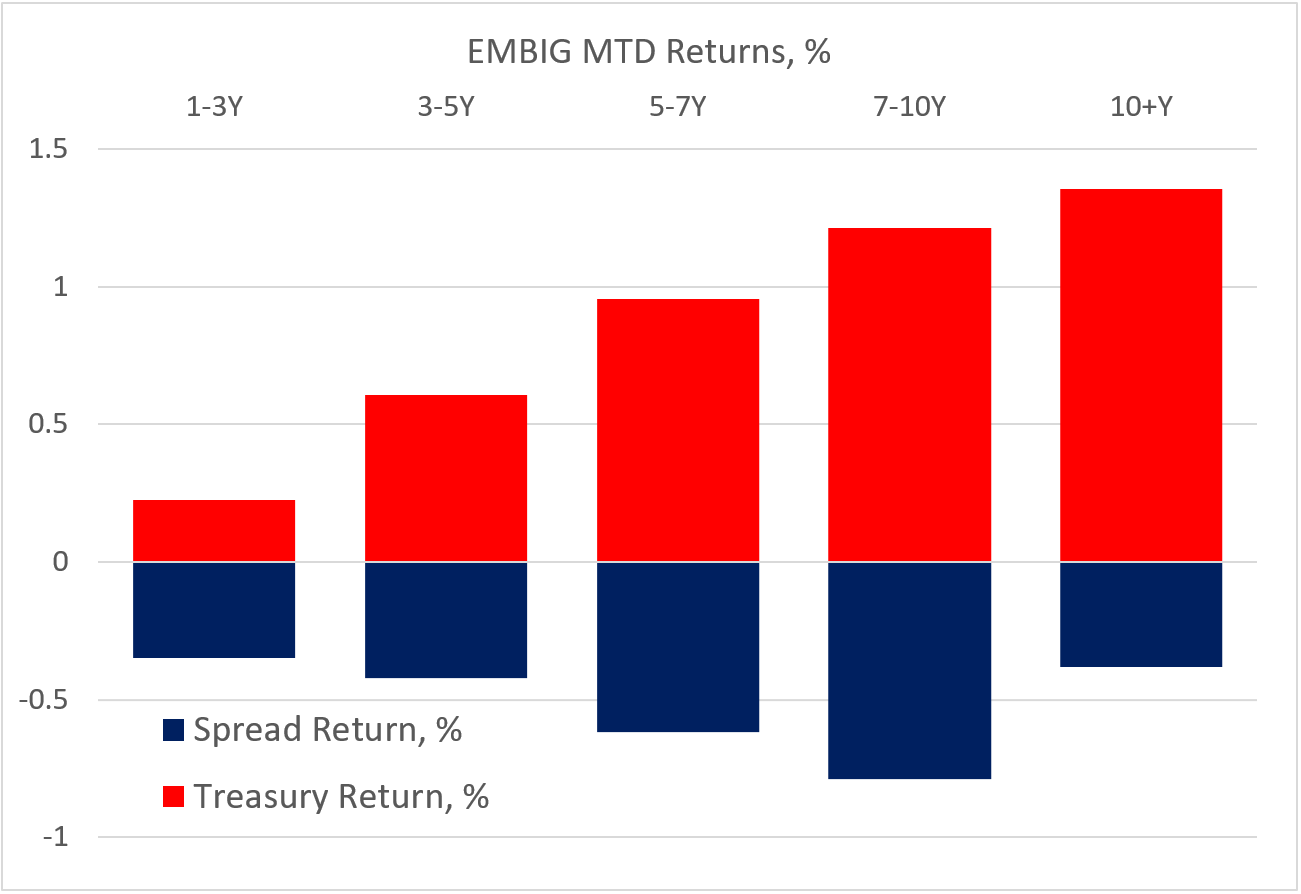The Pivot Talk Is Back
October 04, 2022
Read Time 2 MIN
DM Tightening Cycle
Yesterday’s soft ISM (Institute for Supply Management) survey in the U.S. and a smaller than expected overnight rate hike in Australia brought back a specter of the dovish policy pivot. The Fed Funds Futures and European swap curves are still pricing in sizable rate hikes in October (ECB’s +67bps) and November (U.S. Federal Reserve’s 66–68bps). However, the market expectations for terminal policy rates continued to calm down – both in developed markets (DM) and emerging markets (EM), with most notable adjustments in the U.K, the Eurozone, South Korea, Chile, South Africa, Colombia, and Malaysia. Nominal yields staged a big rally this morning and most global equity indices were in the black as well. In emerging markets, duration outperformed big time so far this month, driven by treasury return (see chart below). But is it too early to relax as regards inflation pressures in EM?
LATAM Inflation Pressures
Governor of the Chilean central bank said this morning that the economy needs further adjustment in order to bring inflation back to target – even though the consensus believes that headline inflation peaked in August, and that the September print (out on Friday) should moderate. One way to interpret Governor’s remarks is that the central bank will keep the policy rate sufficiently restrictive to stop overheating, which was partially “fed” by a string of withdrawals from private pension funds. Colombia might have hiked by less than expected last week, but tomorrow’ inflation print is likely to show further acceleration. The just–released central bank minutes sounded reasonably hawkish and signaled more rate hikes, because inflation is still far from the target (un–anchoring inflation expectations), and the economy is growing above potential, contributing to a wide current account deficit (around 6% of GDP), which “might be harder to finance in an environment of more challenging financial conditions”. Mexico’s inflation is also expected to rise more in September, justifying the market expectation of another 75bps of tightening before year–end.
Asia Policy Rates
There will be several inflation releases in EM Asia after the market close in New York today. We will be paying special attention to Thailand, because the central bank is widely perceived as being behind the curve, and Thailand is at the bottom half of the EM local debt “league table” (J.P. Morgan GBI–EM Index) as regards year–to–date total return (U.S. Dollar unhedged). The market expects the central bank to do a lot of catching up in the next 12 months – Thailand’s local swap curve shows the fastest pace of rate hikes in EM Asia (+167bps). But if annual inflation indeed moderates sharply from 7.86% to 6.58% in September (as consensus sees it), the central bank can feel more comfortable with its very gradual pace of tightening going forward. Stay tuned!
Chart at a Glance: EM Duration Drives Sovereign Returns

Source: Bloomberg LP.
Related Topics
Related Insights
February 26, 2024
January 04, 2024
October 27, 2023
PMI – Purchasing Managers’ Index: economic indicators derived from monthly surveys of private sector companies. A reading above 50 indicates expansion, and a reading below 50 indicates contraction; ISM – Institute for Supply Management PMI: ISM releases an index based on more than 400 purchasing and supply managers surveys; both in the manufacturing and non-manufacturing industries; CPI – Consumer Price Index: an index of the variation in prices paid by typical consumers for retail goods and other items; PPI – Producer Price Index: a family of indexes that measures the average change in selling prices received by domestic producers of goods and services over time; PCE inflation – Personal Consumption Expenditures Price Index: one measure of U.S. inflation, tracking the change in prices of goods and services purchased by consumers throughout the economy; MSCI – Morgan Stanley Capital International: an American provider of equity, fixed income, hedge fund stock market indexes, and equity portfolio analysis tools; VIX – CBOE Volatility Index: an index created by the Chicago Board Options Exchange (CBOE), which shows the market's expectation of 30-day volatility. It is constructed using the implied volatilities on S&P 500 index options.; GBI-EM – JP Morgan’s Government Bond Index – Emerging Markets: comprehensive emerging market debt benchmarks that track local currency bonds issued by Emerging market governments; EMBI – JP Morgan’s Emerging Market Bond Index: JP Morgan's index of dollar-denominated sovereign bonds issued by a selection of emerging market countries; EMBIG - JP Morgan’s Emerging Market Bond Index Global: tracks total returns for traded external debt instruments in emerging markets.
The information presented does not involve the rendering of personalized investment, financial, legal, or tax advice. This is not an offer to buy or sell, or a solicitation of any offer to buy or sell any of the securities mentioned herein. Certain statements contained herein may constitute projections, forecasts and other forward looking statements, which do not reflect actual results. Certain information may be provided by third-party sources and, although believed to be reliable, it has not been independently verified and its accuracy or completeness cannot be guaranteed. Any opinions, projections, forecasts, and forward-looking statements presented herein are valid as the date of this communication and are subject to change. The information herein represents the opinion of the author(s), but not necessarily those of VanEck.
Investing in international markets carries risks such as currency fluctuation, regulatory risks, economic and political instability. Emerging markets involve heightened risks related to the same factors as well as increased volatility, lower trading volume, and less liquidity. Emerging markets can have greater custodial and operational risks, and less developed legal and accounting systems than developed markets.
All investing is subject to risk, including the possible loss of the money you invest. As with any investment strategy, there is no guarantee that investment objectives will be met and investors may lose money. Diversification does not ensure a profit or protect against a loss in a declining market. Past performance is no guarantee of future performance.
PMI – Purchasing Managers’ Index: economic indicators derived from monthly surveys of private sector companies. A reading above 50 indicates expansion, and a reading below 50 indicates contraction; ISM – Institute for Supply Management PMI: ISM releases an index based on more than 400 purchasing and supply managers surveys; both in the manufacturing and non-manufacturing industries; CPI – Consumer Price Index: an index of the variation in prices paid by typical consumers for retail goods and other items; PPI – Producer Price Index: a family of indexes that measures the average change in selling prices received by domestic producers of goods and services over time; PCE inflation – Personal Consumption Expenditures Price Index: one measure of U.S. inflation, tracking the change in prices of goods and services purchased by consumers throughout the economy; MSCI – Morgan Stanley Capital International: an American provider of equity, fixed income, hedge fund stock market indexes, and equity portfolio analysis tools; VIX – CBOE Volatility Index: an index created by the Chicago Board Options Exchange (CBOE), which shows the market's expectation of 30-day volatility. It is constructed using the implied volatilities on S&P 500 index options.; GBI-EM – JP Morgan’s Government Bond Index – Emerging Markets: comprehensive emerging market debt benchmarks that track local currency bonds issued by Emerging market governments; EMBI – JP Morgan’s Emerging Market Bond Index: JP Morgan's index of dollar-denominated sovereign bonds issued by a selection of emerging market countries; EMBIG - JP Morgan’s Emerging Market Bond Index Global: tracks total returns for traded external debt instruments in emerging markets.
The information presented does not involve the rendering of personalized investment, financial, legal, or tax advice. This is not an offer to buy or sell, or a solicitation of any offer to buy or sell any of the securities mentioned herein. Certain statements contained herein may constitute projections, forecasts and other forward looking statements, which do not reflect actual results. Certain information may be provided by third-party sources and, although believed to be reliable, it has not been independently verified and its accuracy or completeness cannot be guaranteed. Any opinions, projections, forecasts, and forward-looking statements presented herein are valid as the date of this communication and are subject to change. The information herein represents the opinion of the author(s), but not necessarily those of VanEck.
Investing in international markets carries risks such as currency fluctuation, regulatory risks, economic and political instability. Emerging markets involve heightened risks related to the same factors as well as increased volatility, lower trading volume, and less liquidity. Emerging markets can have greater custodial and operational risks, and less developed legal and accounting systems than developed markets.
All investing is subject to risk, including the possible loss of the money you invest. As with any investment strategy, there is no guarantee that investment objectives will be met and investors may lose money. Diversification does not ensure a profit or protect against a loss in a declining market. Past performance is no guarantee of future performance.

